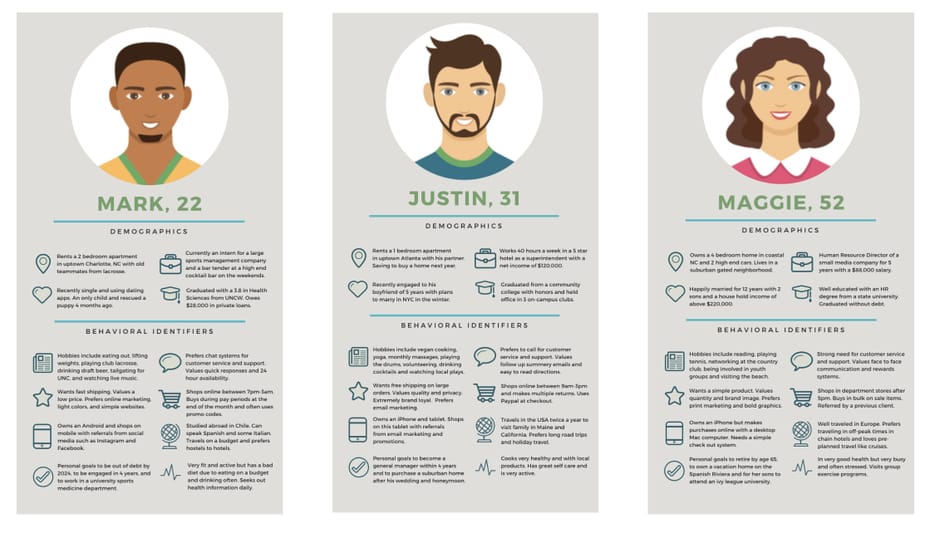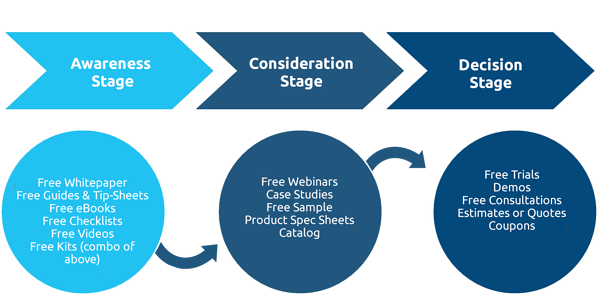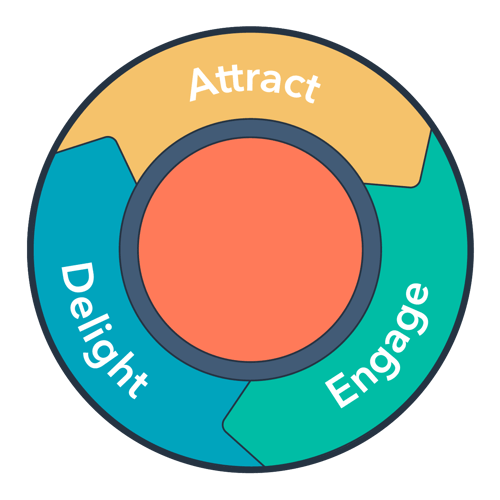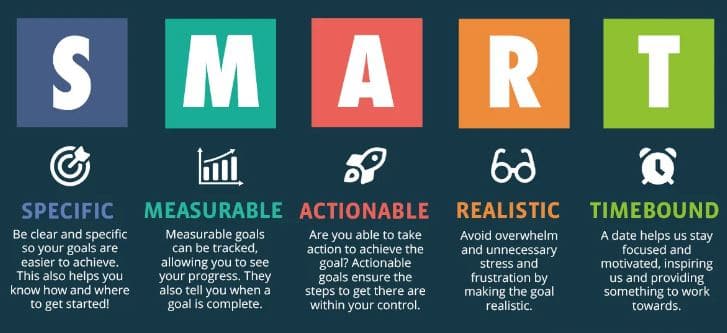We get bombarded by marketing messages 24/7, and most people ignore 99% of them. So, as marketers, how do we get our message noticed?
The marketing landscape is constantly evolving and changing. If you haven't started preparing for 2023 yet, then you're already falling behind!
Keep reading to find out how you can get noticed with inbound marketing in 2023.
Contents
- What is inbound marketing?
- Why is inbound marketing a better way to market?
- How does inbound marketing work?
- Some examples of inbound marketing tactics
- Why inbound marketing is better than traditional, outbound marketing
- What's the difference between inbound marketing and content marketing
- Identifying an inbound marketing campaign
- How inbound marketing can improve your sales
- How to get started in inbound marketing
- Software and tools for inbound marketing
I'm the CEO of a 35-person HubSpot partner in South Africa. I try to write and share content that's helpful and positions us as thought leaders in our region. This is the story and strategy of inbound marketing. I hope to share this with you below.
1. What is Inbound Marketing?
Inbound marketing focuses on providing value to your leads before they even become customers.
By providing helpful and insightful content, you can foster trust and hold the attention of your leads. Trust will naturally attract leads to your company/brand.
Don't just shove your messaging at your potential customers hoping someone bites. It's like a billboard on the side of the road: thousands of people will see it, but are they the right people? Perhaps 2 out of 10 people will react to your message; the rest will just move on with their day.
Inbound marketing, however, allows you to build up a reputation and relationship with leads while they’re still researching their options. People aren’t always going to be ready (or enabled) to buy, but when they are, they’ll seek you out.
Why?
Because you’ve built a foundation of trust with them before they’ve ever even done business with you.
The biggest differentiator of inbound marketing is that it focuses on helping people instead of selling products.
By helping people and providing solutions to problems, you can start building trust, and with this trust, you’re more likely to be their preferred supplier down the line.
2. Why is Inbound Marketing a better way to market?
We build Inbound campaigns for all our new HubSpot clients that we onboard to HubSpot. It's one of the first things we do. We do this because it's a better way to market a business.
We also get our client to do the Inbound Marketing certification from HubSpot.
Inbound marketing is the best way to market in the digital domain. Inbound marketing is a tried-and-tested technique that has proven to be a massive success for thousands of businesses all around the world. As long as you get it right, your business can thrive.

Why?
Because it allows you to reach your potential customers organically and attract them to your brand in an uninterrupted way, rather than forcing your marketing onto them.
Instead of interrupting them with badly timed cold calls and marketing material that doesn't speak to their unique needs, inbound marketing builds long-term relationships with your prospects and customers. It's always better to receive marketing from a brand that you know, trust, and want to hear from.
It positions your brand as valuable and trustworthy.
3. How does Inbound Marketing work?
Inbound Marketing is a highly effective strategy to improve marketing ROI and create customer delight, but how does it actually work?
There are a few core principles at the heart of inbound marketing that make it work.
Buyer Personas
Inbound marketing is all about understanding your customer. Unlike other forms of marketing, you're not just sending your message out there to be seen by the whole world hoping someone who is interested might see it. Instead, you're trying to target specific people who you know will be interested!
Who are you really speaking to? What problems do they face? Do they have goals you can help them achieve?
By understanding your customers, you can create buyer personas. These semi-fictional representations of your ideal customers enable you to strategically formulate your marketing in a way that appeals to them.
Buyer personas will help you to create an "information pack" on everything you need to personalise your marketing and sales, from the content you produce to the way you position pain points in your sales pitches.

Source: Boagworks
By understanding your buyer personas, you can shape your marketing, sales, and service strategy in a way that will resonate with your potential customers.
The Buyers Journey
The inbound methodology is built on the fact that your leads fall into different stages of a buyer's journey.
The basic premise is that you need to talk to that lead like you know what stage they are in. If you miss the boat here - you will miss the opportunity to establish trust.
Below is an image of the three stages in the buyer's journey. It also demonstrates the type of content we suggest using to nurture and engage potential customers in each stage.

In addition to the buyer's journey, we recommend thinking about your marketing and sales strategies as a flywheel.
Businesses using inbound use the flywheel methodology to build trust, credibility, and momentum.
Imagine adding value for your prospects and customers at every touchpoint they have with your business.
Notice above that we mentioned 'customers'. The flywheel takes you beyond client acquisition and into retention and referrals (Delight).

ATTRACT
Inbound marketing attracts leads to your business by providing content that solves their pain points, responds to their needs, and gives valuable and relevant insight.
People can be introduced to your content through a variety of channels: Sales outreach, Google search, paid ads, social media, email, webinars and events, and referrals.
ENGAGE
Engaging is about building trust and relationships with both prospects and customers. This is done by providing relevant insights and solutions that align with their pain points and goals.
Make it easy for customers and prospects to engage with your product and potentially purchase it. This could be in the form of free trials, free consulting, proof of concepts, or entry-level versions of your product or service.
DELIGHT
The best marketing you’ll ever have is a happy customer.
Through word-of-mouth and referrals, your customers will generate more customers and move deeper into your products and services.
The key to getting this right is to delight the people you’re dealing with through excellent service and quality products.
By keeping your customers at the centre of your marketing, you’ll create delight.
Why does the flywheel work?
The flywheel works because it considers each person in the flywheel individually, and makes sure every touchpoint in the flywheel is relevant.
Each relevant touchpoint speeds up the flywheel and increases its effectiveness as a whole.
Smart Goals
Everyone seems to glaze over when SMART goals are mentioned.
But the importance of SMART goals can't be overstated. It's surprising how often marketers work with unclear and ill-defined goals.
Marketing without a goal to work towards is pointless.
You need to know what you’re working towards, or you’ll never have a benchmark of success. Ask any inbound marketer about the first step to take when setting an inbound marketing strategy, and they’ll tell you to set SMART goals.
SMART Goals are specific, measurable, attainable, relevant, and timely. Setting them with the marketing and sales team means everybody can stay on the right path and deliver the right results to achieve these goals.
 Source: DougThorp
Source: DougThorp
An example of an inbound SMART goal:
We will increase Sales Qualified Leads (SQL's) from the current level of 100 per month (year to date) to 140 per month by the end of Sept this year.
4. What are some examples of Inbound Marketing Tactics?
In addition to using buyer personas and content marketing, inbound marketing works through a variety of inbound marketing tactics, including:
- SEO
- Gated Assets like ebooks, whitepapers, checklists and infographics
- Social media marketing
- Email marketing
- Video marketing
- Lead nurturing via automated emails
- Marketing automation
- Paid Media Advertising
Remember, it's not the tactics that make a strategy inbound. It is all in the timing and relevancy that the content is delivered.
These tactics can work together to create a seamless inbound marketing strategy.
5. Why is Inbound Marketing better than traditional outbound marketing?
Inbound marketing takes the approach of attracting leads by providing quality, helpful content. This content is designed to address pain points and provide helpful information on how to solve the potential customer's problems.

Outbound marketing takes the opposite approach. It is interruptive and is geared to telling people what you want them to know about your product.
Instead of creating useful marketing information for them to find, outbound marketing is about putting a message out there (that is more focused on your product than providing informative and helpful content) and hoping that someone sees it at exactly the right time.
6. What's the difference between inbound marketing and content marketing?
Content creation is the engine of inbound marketing, but content marketing and inbound marketing often get confused because of how similar they seem.
Both rely on content to work, but inbound marketing is a more targeted version of content marketing. You need to make sure that you're attracting customers with your content, rather than putting content in front of as many eyes as possible — this is the key difference.
As we've covered in the sections above - inbound marketing is about putting relevant content in front of the prospect at a time when they are most receptive to the content. This will prompt them to take action and your leads will be converted.
It can be argued that this is what content marketing is. But in truth content marketing is about great engaging content, and getting it out there to as many people as possible. This doesn't necessarily mean that people are ready or willing to buy!
"As many people as possible" is not inbound.
With inbound marketing, we'd rather get our content in front of fewer - but much more relevant and targeted prospects that guarantees conversions.
Read more about the difference between inbound marketing and content marketing here.
What type of content is used in an inbound marketing campaign?
Content for inbound goes far beyond just blogging (although blogs are a central element in a content strategy) A variety of other assets and pieces that you might not even realise are classified as “content” make very powerful 'assets' in inbound marketing campaigns. These can include:
- Blog articles
- eBooks
- Infographics
- Interviews
- Social media posting
- Videos
- Website copy
- Podcasts
- Webinars
7. Identifying an inbound marketing campaign
An inbound marketing campaign is a strategy to attract leads, converts them into customers, and delights them into becoming your biggest brand evangelists.
Inbound marketing campaigns make use of content and assets gated behind forms to attract leads and capture their details.
Generally, each campaign has a specific goal, a specific persona in mind, as well as a set timeline.
Read about how you can identify an inbound campaign here.
8. How does inbound marketing improve your sales and grow your business?
Inbound marketing works to break down the silos between the sales and marketing teams.
One of the biggest challenges faced by businesses today is that sales and marketing fail to align on what a good prospect looks like, and how best to nurture them.
Inbound marketing advocates for ‘smarketing’ - the combination of marketing and sales teams' efforts.
Inbound marketing generates higher quality leads that are more likely to convert. When the marketing team is generating high-quality leads, the sales team wants to know more.
They want to give their feedback to generate more opportunities.
They want more of these leads to follow up on.
Opening up these lines of communication is the key to better lead quality.
With quality feedback from sales, the marketing teams start to better understand what makes a great potential customer. They start to create more content and strategies that attract those leads.
And the sales team is right there giving feedback without the need to drive the collaboration.
Smarketing.
Learn about the role of marketing in the modern sales process, and how you can grow your business.

9. What do you need to get started in inbound marketing
These are a few of the absolute basics to getting started with inbound marketing, but it's not a definitive list of everything involved in launching Inbound Marketing.
Website
Your website is your business’s home on the web, and these days it has become essential. It is where your leads find you, and it is your base platform to provide helpful information about your business to the world.
Think about the last time you were looking for a service. Chances are, you did a Google search and looked at a few websites before making the decision to pick up the phone or leave an enquiry.
If you don’t have an effective website, you’re immediately disqualified from the competitive online world. After a Google search, internet users will quickly scan through websites, and if you can't hold their attention for more than 30 seconds, they'll quickly move on to the next one!
This makes your website the absolute starting point of inbound marketing.
Blog
People tend to place more trust in companies that act as thought leaders in their industry.
Having a blog on your website allows you to showcase content to your reader-base that is insightful and shows that your company offers knowledge beyond what they’re looking for.
It's the starting point to providing valuable content that will draw leads in to your business and convert them into customers.
Content strategy
Inbound marketing is an engine fuelled by content. With the right content, your marketing is going to nurture leads and convert them into customers.
With the right articles and content targeted towards your buyer personas and the right assets gated behind forms and landing pages, you can start capturing lead information and start nurturing them.
The right people
Make sure you have the right people working with you.
You people need to truly care about your company/brand and have an understanding of how inbound marketing works.
You can either hire someone in-house or collaborate with a HubSpot partner agency to get your inbound marketing up and running.
10. Software and tools for Inbound Marketing
Website & blog
We recommend two CMS platforms for websites, and this is mostly because they handle content so well.
WordPress & HubSpot CMS. (Shopify if you are in eCommerce)
Don't get distracted by shiny objects here. Headless CMS's custom this, custom that. WordPress. HubSpot CMS. That's it.
Trust me - I've seen the train wrecks.
The most user-friendly website software that is Google-friendly and relatively inexpensive is WordPress. Get an agency to rebuild your website in WordPress. You can teach yourself to maintain it once they are done, it's much easier than you might expect!
CMS's like Joomla and Drupal have long ago seen their best days. If you're on one of these - change NOW. You can't do modern digital marketing with these dinosaurs.
If you are a fan of HubSpot, we recommend HubSpot CMS.
It's not cheap at $300 p/m, but it rocks our world when it comes to super simple content creation, management and leveraging it in the marketing and sales domain.
Our website is built in HubSpot CMS.
You can also run a hybrid, building your website pages on WordPress and the blog on HubSpot. For this, you'll need a HubSpot Marketing Pro licence which is $800 p/m.
Marketing Automation
Now while you don't have to have marketing automation to do inbound marketing, it does help when you are doing inbound at scale.
So what does scale mean?
Let's say you are spending R20k+ on paid ads per month, or your contact base runs into the thousands - then marketing automation is a must.
Workflows that trigger emails and sharing content pieces change the game and allow you to share relevant content 24/7.
HubSpot is the undisputed champion in his realm, but there are some more affordable marketing automation software options out there.
CRM
We always recommend HubSpot CRM, because it's free and easy to use, but still a very powerful CRM.
A CRM allows you to align your marketing efforts with your sales or sales teams.
Tracking how your contacts have interacted with your company online is critical to presenting them with the right pieces of content at the right time - a critical component of inbound marketing.
Social Media
Social is such a great way to distribute your content to a targeted audience.
LinkedIn works great for businesses in the B2B space.
Facebook works better for B2C selling.
Using a social media management tool like HubSpot, Social Sprout, and Hootsuite help you to understand how your content is performing across platforms without the need to pull the data from the individual platforms.
HubSpot goes even further to compare your contents' performance on social versus organic and even paid search ads on search engines.
The best targeting on social platforms is gained with paid advertising on LinkedIn and Facebook. Each of these has several different types of ads that you can utilise to your advantage.
Software for Inbound Marketing
Below is a selection of the best software and tools to make your inbound marketing yield top results.
Marketing automation: HubSpot Marketing
Alternatives: Marketo, ActiveCampaign
Relationship management: HubSpot CRM
Alternatives: Pipedrive, Salesforce
Landing pages: HubSpot Marketing
Alternatives: Unbounce
Live chat: Drift
Alternatives: HubSpot Marketing/HubSpot Sales, Intercom
Video marketing: Vidyard
Alternatives: Wistia, TwentyThree
Email marketing: MailChimp
Alternatives: HubSpot Marketing
Email productivity: HubSpot Sales
Alternatives: Outreach
Social media management: Hootsuite
Alternatives: HubSpot Marketing, Buffer
In closing
In an era of marketing message overload, inbound marketing is ethical and it's incredibly effective.
Inbound marketing is what we should all be adopting when it comes to our online marketing strategies, but it's always overlooked!
Trust me - it works. I run a successful business utilising the inbound methodology.
And we've helped countless customers do the same. Check out this guide if you're looking for a HubSpot Partner in South Africa.





